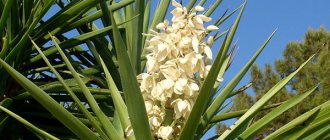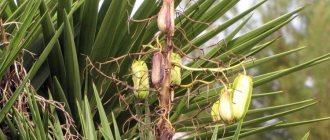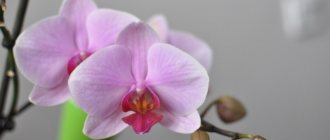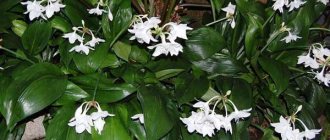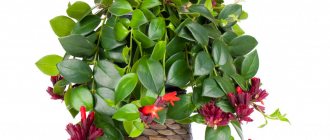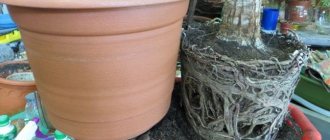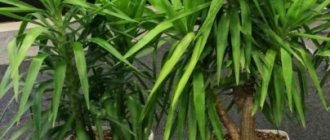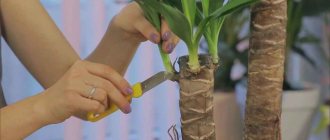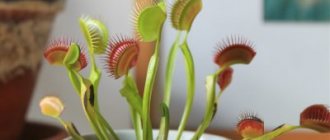Yucca is called the "palm lily". The flower belongs to the Agave family; there are about 40 species. Outwardly it resembles a small palm tree.
The distribution area of yucca is the deserts of North America; several varieties are found in the center of this continent, as well as on the islands of the Caribbean and in Asia. Prefers rocky soils and areas with plenty of sunlight. Garden plants can be up to 10 meters high and look like a tree. At home, yucca does not grow higher than 1 m.
Landing
The well-being of the plant will ensure that certain rules when planting the plant after purchase.
In the garden
For the garden, plants with a closed root system are usually purchased - in a container . This yucca can be planted at almost any time of the year, the root system will not be damaged, but it is better at the beginning of the warm season, then adaptation will be painless.
Homemade yucca palm: care at home
After purchasing a yucca, it, like all new plants, is quarantined for at least 2 weeks - placed separately in a place with diffused light. During this time, the plant adapts to the microclimate of the room, and all possible ailments will be identified and cured.
After the adaptation period, the yucca can be transferred to a suitable container and placed in a permanent place.
Lighting
Yucca loves good lighting . Its leaves are covered with a thin layer of waxy coating; they are dense, tough and perfectly adapted to all kinds of living conditions. Therefore, she is not afraid of even the brightest sunlight. In summer it can withstand even the brightest sun provided there is good aeration, i.e. sufficient supply of fresh air.
In winter, lighting depends on temperature .
Temperature
In summer, the air temperature can be almost any : yucca tolerates temperatures above 30, especially in the fresh air or in a well-ventilated area.
Rest period
In winter, yucca needs coolness for at least 2 months. This is not a slight drop in temperature, but rather cool conditions, +5 - +8°C.
With such maintenance, lighting does not play - the plant is at rest and does not grow .
This period is very important for development - flower buds are laid. With such content, additional lighting may not be necessary.
If it is not possible to arrange a cool winter, then it is necessary to provide the plant with as much natural and artificial light as possible, otherwise it will stretch, bend the trunk and fade.
When grown in the garden, yucca sometimes requires shelter for the winter. The yucca is wrapped in several layers of thick paper or cardboard, the packaging is secured, and the ground around is mulched with sawdust, straw, or insulated with spruce branches.
In areas where the winter temperature drops below -10°C , it is advisable to grow yucca year-round in a pot, taking it outside during the warm season.
Air humidity
Yucca tolerates dry indoor air, but atmospheric moisture has a positive effect on its appearance and well-being, especially at high temperatures.
Watering
In the warm season, with active growth, you need to water abundantly , but not often. Moisten the soil for yucca in a pot only after the earthen clod has completely dried out.
IMPORTANT! When water stagnates, fungi and algae very quickly settle in the soil, to which yucca is sensitive.
during the dormant period is even more dangerous . At this time, there is a high risk of root rotting. In the cool winter, yucca is watered very rarely and very little at a time so that the roots do not dry out. This is exactly the case when it is better to underfill than overfill.
Caring for Yucca at home
The presented types of Yucca will fit perfectly into the interior of your apartment, will green it, and will not require much sacrifice and time from you. Just follow the basic rules for growing it, which we will now introduce you to.
Lighting and location of the pot
Light-loving Yuccas are best placed on flower stands near eastern or western window sills in an apartment. The place should be sunny, well lit throughout the day - the growth, development and appearance of your flower will depend on this. For this reason, you should not place the pot on the floor - there will not be enough light. It is necessary that the stand for it be flush with the window sill.
If you place a pot with a flower near the southern windows, then at midday you will have to protect the Yucca from direct rays of the sun with light curtains or blinds so that its leaves do not get sunburned.
If the window sills in your apartment are wide and the Yucca bushes are still young, then you can easily keep them on the windowsill. Just make sure that in the summer the sun does not burn them, and in the winter the leaves do not touch the cold glass.
In winter, the plant will lack natural light from any window. You will have to take care of this in advance and purchase a fluorescent lamp or phytolamp to turn it on if necessary at a distance of 50–60 cm from the flower in order to artificially extend the daylight hours for Yucca to 12 hours a day.
Yucca loves fresh air. We recommend taking the flower pot out onto the balcony or veranda. Just not in the open sun!
Ventilation of the room in autumn-winter is also necessary for the flower, but do not forget that drafts are contraindicated for it.
Temperature
The temperature of the flower should be kept around 22–26 degrees. The usual temperature of city apartments is quite suitable for it, in which the flower develops well and looks healthy. In winter, it is advisable to lower the temperature to 16–20 degrees. During the heating season, Yucca begins to suffer from hot air. Its leaves begin to stretch out, thin out, and turgor weakens. Try to reduce the temperature in the room by ventilation or using split systems. Cover batteries using improvised means. Avoid sudden temperature changes.
Sometimes the owner opens the windows for ventilation in winter and forgets to take Yucca into the next room. A short time is enough to ruin a plant and then regret it for a long time. The lower temperature limit in winter for indoor Yucca is 8 degrees. heat.
Humidity
Yucca does not require high ambient humidity. The humidity of our city apartments suits it - 40–50%. If the humidity is even lower and the temperature is high, for example, during the heating season, we recommend spraying the surrounding air and the leaves of the flower with boiled or well-settled water at room temperature. Just make sure that the wet leaves of the flower are not exposed to sunlight through the window glass - the plant can get burned and lose its decorative appearance.
This may be interesting: Rules for caring for Dieffenbachia at home
To keep the leaves clean and improve their respiration during the hot season, the crown should be wiped with a damp cloth. A flower with wet leaves cannot be placed in the sun - it will get burned. Therefore, it is advisable to carry out this procedure in the evening so that the crown dries out overnight.
Watering
There is no single rule for watering Yucca. The amount and frequency of watering depend on the time of year, humidity indoors or outdoors (depending on where the flower is located), the size of the flower and its pot. For example, a young plant, just bought in a store and transplanted into a new pot, should be moistened a little almost every day, and an adult flower growing in a huge pot can be watered once every two to three weeks. We will give general recommendations on this matter.
In summer, watering should be plentiful, but not frequent. Wait until the top layer of soil 4–7 cm deep dries out, only then water again. Use only settled or boiled water at room temperature. If the air temperature is about 20–22 degrees, water no more than once a week. In autumn-winter, watering is reduced. One watering every 10–14 days may be sufficient. The cooler the air in the room becomes, the less often you should water the flower. If the temperature remains at 18 degrees for a long time, one watering every 3 weeks is sufficient.
It has been noticed that it is enough to pour 1 liter of water into a 5 liter pot. Yucca tolerates dry soil more easily than overwatering. At any time of the year, do not allow excess water to stagnate in the pan, so as not to provoke rotting of the Yucca root system. If brown spots appear on the leaves and they begin to curl, it means that the roots have begun to rot due to waterlogging of the substrate. In addition, waterlogged soil often causes the plant to be attacked by all sorts of pests.
If the top layer of the substrate remains wet for several days after watering, the substrate may have become very hardened and does not allow water to pass to the roots inside the pot. In this case, you urgently need to loosen the soil with some available tool, or at least a fork.
Or perhaps the humidity level in your apartment has increased significantly. The soil began to dry more slowly. By maintaining the usual watering regime, you risk ruining the root system of the plant.
In hot weather, it is advisable to arrange a shower for Yucca. Wash its leaves well to remove dust, but make sure that water does not get on the substrate (cover the soil with polyethylene while bathing). After your shower, place the pot in a place where there are no drafts or direct sunlight. When the leaves are dry, you can take the flower to its place.
Fertilizers
Feeding Yucca is a necessary condition for its successful cultivation from April to August. Foliar feeding with mineral liquid compositions has an advantage. Just dilute them with twice as much water as indicated in the instructions for the drug. Spray the undersides of the leaves with the preparation - Yucca reacts well to this. Foliar feeding is combined with regular watering of the flower. Purchase liquid mineral fertilizers for blooming indoor flowers in special stores. During the period of active growth, feed Yucca once every 2 weeks. During illness, after transplantation and in autumn-winter, the flower is not fed.
If, when replanting the plant, you used special balanced soil for Palms or Dracaenas, then Yucca will have enough nutrition for a long time, and you will not have to feed it until the next season.
This may be interesting: Calathea - subtleties of care
The soil
Yucca prefers light, loose, but quite nutritious substrates, in which leaf, turf soil, peat, humus and coarse sand are found in equal proportions. You can use ready-made soil mixtures. The composition is suitable for soil for Palms or Dracaenas with a neutral or slightly acidic environment. Or you can prepare the soil yourself. In any case, we recommend disinfecting the substrate before use in any way - calcining or freezing it to prevent the presence of infection and insects.
Transfer
After purchasing Yucca, do not immediately place it in the prepared place - give it a little time to acclimatize to new living conditions away from other flowers. Transplant the flower into a new pot larger than the transport container. Prepare a new substrate as well. Be sure to place a good layer of drainage on the bottom of the pot - expanded clay or crushed stone, at least 5 cm. Replant the flower using the transshipment method. Do not deepen the stem too much. Immersion to a depth greater than 3 cm is fraught with rotting of the trunk and death of the Yucca. After transplanting, water the plant and place it separately from the others for a couple of weeks to monitor it. Do not place the pot in the sun, in a draft, or in a room that is too hot. After the expiration date, a healthy-looking Yucca can be moved to its planned location.
A planned transplant of Yucca into another, larger pot is carried out for young specimens once a year, for more mature ones - once every two to four years, with partial replacement of the old soil with new one. There are no special restrictions on the time of transplantation, but it is still better to replant it in the spring. The reason for the transplant may be that the Yucca root system has grown throughout the pot. When removing a flower from an old one and placing it in a new pot, try not to damage the root system. Otherwise, the flower may get sick, and the adaptation process will take a long time, if not worse.
Try to ensure that the new substrate with which you fill the voids in the pot is of the same composition as the previous one, then the adaptation time will pass faster. Another condition: within a month, the transplanted flower cannot be fed, cut or cut! Let him adapt to the new living conditions in peace.
Large flowers are not very stable. Therefore, it is planted in a large pot. To prevent acidification of the soil, rippers are added to it - vermiculite, perlite or expanded clay chips in a ratio of 5 to 1.
If the plant is too large and you do not want it to grow further, use an old pot when replanting, and trim the root system of the flower by a quarter with a clean tool. Treat the cut areas with crushed charcoal, possibly charcoal, or activated charcoal. In an old, but cleaned and disinfected pot, pour 5 cm of new drainage and part of the new soil. The flower is installed and its roots are covered with substrate. There should be fresh soil on both the top and sides of the pot. After transplanting, do not water the Yucca for a couple of days, and then begin to carefully moisten the substrate in portions, waiting for its surface to dry.
It is problematic to replant an adult plant that has reached monumental size. Usually they are content with annually replacing the old soil from the top of the pot with new soil.
How to prune Yucca
Pruning is carried out to rejuvenate the plant and give it a beautiful shape. If, for example, your Yucca begins to grow, losing its decorative appearance, cut the branch, leaving two to three buds (growth points). Treat the cut areas with crushed coal. The cut branch can be used for propagation. The old lower leaves of Yucca are also trimmed, dry and broken ones are cut off. Pruning is carried out in early spring, when the flower has not yet begun to actively grow. The instrument must be disinfected with alcohol or vodka. Make the cut to the end, do not break off branches with leaves - with careless movements you can damage the growing points. To prevent rotting processes, immediately treat all cuts with crushed coal. Cut off parts of Yucca can be used for propagation. Read more about Yucca propagation in the article Yucca - propagation, diseases and pests.
Rest period
Yucca does not have a pronounced period of rest. It needs good lighting, moderate ambient temperature, and moderate watering all year round. If you take it out into an unheated room for the winter, keep in mind that the temperature is below 8 degrees. heat is critical for her.
Transfer
Young specimens of the plant are replanted annually in the spring . There are three ways to change the amount and composition of soil in a container - transshipment, replanting, and replacing the top layer.
Transshipment
The essence of the method is to simply remove the plant from the pot and transfer it to another, slightly larger one, along with a lump of earth.
Fill the gaps between the roots and the container with fresh soil. First pour drainage ; after installation, you can change the top layer by carefully removing it and adding fresh mixture .
Complete change of soil
In this procedure, it is important to remove as much soil as possible, untangle and trim the roots, remove rotten ones, while trying not to injure whole and short ones. It is convenient to free the roots with a stick .
a pot prepared in advance , the substrate is poured into a mound, and the plant is placed on it. When filling the roots, shake the pot from time to time or tap it on the table - the earth penetrates inside the root lobe. The surface level is not changed; the diameter of the pot is 1–2 cm larger than the previous one, or the same if the roots are severely pruned.
Changing the ground layer
For large adult plants, the transplantation of which is difficult, the top layer of the soil mixture replaced To do this, carefully remove the surface of the substrate and add fresh one in its place.
Soils
The palm tree does not need excessively nutritious soil. Yucca soil from the store or any other neutral mixture will do. Too rich soil is diluted 1/4 with sand .
Insulation of garden yucca
A logical question often arises - how to properly insulate a garden yucca for the winter and is it necessary to do it?
Filamentous and glaucous yucca are frost-resistant, being quite painless in the face of a short drop in air temperature. In regions with cold winters, garden yucca needs to be insulated.
There are several methods of insulation:
Collect yucca leaves and tie them with twine. To prevent the ground from freezing, place the lower leaves on the ground. The soil near the bush is covered with dried leaves, and boards are laid on top to prevent it from being blown away by the wind.
After this, the bush is covered with polyethylene, the lower part of the trunk is sprinkled with soil.
Bacopa - description of the species, cultivation, care, reproduction + 74 photosGarden hibiscus - types, description, planting, care and propagation + 69 photos
- Celosia - growing from seeds and seedlings, planting in the ground and care rules + 80 photos
There is another method of insulation - using a large wooden box covered with dense material, roofing felt or polystyrene foam will do. Then the insulating structure is covered with dried leaves, after which it is covered with spruce branches or straw, and a film can be placed on top.
It is recommended to carry out insulation in late autumn, at the end of October-November, and it is worth removing the protection only when any threat of cold weather and frost has passed.
Garden yucca will help create an unusual exotic corner on your site. This beautiful tropical plant is extremely unpretentious. With proper care, yucca will delight you for a very long time.
Feeding
Yucca is fed, like all other plants, only during the period of active growth , in the warm season.
But it should be borne in mind that immediately after changing the soil, fertilizers are not required: after transshipment and replacement of the layer, at least a month, and after replanting - two.
Nutrients are applied with watering once a month, gel granules with yucca fertilizer are added to the soil once a season, or sticks are used to continuously supply nutrients to the substrate for a long time.
Territory of growth and adaptability of yucca
Adaptability, combined with the ability to accumulate moisture and protect itself from the harmful effects of the external environment, allows yuccas to grow where other plants in most cases do not survive.
Representatives of the genus can be found on the Caribbean islands and in Guatemala, where the local species Yucca guatemalensis has settled. In the dry subtropical zone, the range includes the Gulf of Mexico and coastal areas of the South Atlantic, where Yucca filamentosa with spiny linear leaves and characteristic threads on the rosette, which gave the species its name, is easy to see on barren wastelands.
Most of the plant's habitats are southern, tropical, and subtropical regions. But several species can be grown outdoors in temperate climates. These are Yucca filamentosa, flaccid, gloriosa and recurvifolia. The variety of yucca shown in the photo with the name gray is recognized as the northernmost. Not only is it not afraid of drought, but it also survives in the Canadian, far from tropical climate.
All representatives of the genus were able to adapt to such diverse climatic conditions:
- thick roots that accumulate moisture;
- durable wax coating on the leaves, preventing water evaporation and wilting;
- dead leaves that do not fall, covering the trunk like a skirt and protecting it from the sun;
- high density wood, which quickly resists even fire and allows yuccas to quickly recover in extreme situations such as fires.
In temperate climates, these features help yuccas withstand cold snaps, short-term frosts and even snow, like the Schotta or large-fruited yucca.
Bloom
Sufficiently mature specimens bloom. At the end of spring and summer, a peduncle appears from the center of the rosette, on which a loose paniculate inflorescence with white or cream fragrant flowers blooms.
The lifespan of a yucca flower is about a month.
Some species of yucca bloom once in a lifetime and are then replaced by young shoots. This makes them similar to agaves.
Flowering does not occur even in the oldest specimens if seasonal maintenance requirements are not met - there is no winter dormancy period.
How yucca blooms - photo:
Varieties of yucca and their characteristics and remarkable qualities
The attention of flower growers and gardeners to the crop was attracted by such valuable qualities of the plant as:
- amazing undemandingness regarding both conditions for planting and subsequent care;
- consistency of appearance throughout the year;
- spectacular shape, different in different species;
- lush flowering;
- the presence of variegated varieties with leaves in yellow, white and purple tones.
The usefulness of the plant was noticed by the American Indians long before gardeners and landscape designers. The roots of Yucca elata or soap tree are rich in saponins, and their decoction served as a kind of shampoo. Dried yucca leaves, the fiber obtained from the stems, were used to make fire and cover roofs.
In rural Appalachia, the Yucca filamentosa pictured here served as a “meat hanger.” Carcasses or pieces of game were pinned onto sharp, hard leaf plates, which were tied and hung for salting, smoking or drying.
Until now, in Mexico and other regions where yucca grows, the petals are used in cooking. Having previously removed the pistil and the bitter base of the corolla, the flowers are blanched for about 5 minutes and then stewed with tomato, chili pepper and onion.
Growing
Yucca does not have any special requirements for living conditions. She can put up with shortcomings in everyday care for a long time. However, compliance with the rules will contribute to the timely achievement of the best decorative performance by the plant. Yucca can decorate any spacious room, and low varieties can decorate limited spaces.
Watch an interesting video about how to care for yucca:
Plant growth
Some types of yucca reach impressive sizes and form a trunk from the vaginal parts of the leaves emerging from a single rosette. The lower ones gradually die off, and a trunk is formed. This growth pattern unites yucca with palm trees.
At home, yuccas, in the absence of shaping pruning, grow up to 2 meters.
But some species grow so slowly that the appearance of a clearly defined trunk is not expected - such yuccas are a ball or hummock , consisting of hard lanceolate leaves sticking out in different directions.
Types and varieties
There are over thirty different species of Yucca. They differ mainly in leaves and sizes. Some species have lanceolate leaves, while others have sword-shaped leaves. In addition, the edges of the leaf blades in some species are covered with long, stiff hairs, in others - with spines, and in others they are smooth. In addition to the usual green leaves, indoor varieties of Yucca have variegated leaves with bright white or yellow stripes. The most popular types: filamentous, ivory, gray, glorious and aloel.
At home, mainly two types are grown - ivory and aloe vera. Less often - filamentous and blue. We are sure that all types of this plant will decorate your home. Let's get to know them better.
Yucca elephantipes
It is named so because of the wide, massive base of the stem, which appears in Yucca in old age, which resembles the foot of an African elephant. This species of Yucca is very unpretentious to living conditions. It grows slowly. It is accustomed to the arid climate of a city apartment, is undemanding to the soil composition and does not take up much space in the room. In addition, other indoor flowers that are resistant to dry soil, for example, indoor Geranium or decorative Kalanchoe, can be planted in a wide pot with Yucca. Against the background of Yucca, pots with Anthurium, Spathiphyllum, and Benjamin ficus look great. Dollar or Money trees will also decorate this floral arrangement.
This may be interesting: How to overcome the difficulties of caring for Poliscias
Yucca filamentous
In the south of Russia, in Crimea and the Caucasus, it grows in open ground and does not require shelter for the winter. In central Russia it is grown with shelter. Sometimes grown at home. This almost stemless plant grows as a shrub with beautiful bluish-green leaves, which have characteristic white or yellow stripes. The length of the leaves reaches 70 cm, width – up to 4 cm. The apex is pointed. The edges of the leaves are slightly drooping and contain numerous twisted white threads. The root system is well developed. The peduncle is very large, rising above the rosette to a height of up to one meter. Yucca blooms with drooping yellowish-white flowers up to 8 cm in length.
Yucca aloelia Marginata
This species is less common in indoor floriculture. It is more demanding in terms of content and takes up more space. It grows slowly, but over time, as it grows, the adult plant takes the shape of a ball with wide, leathery leaves. In the summer, Yucca Marginata blooms. On an inflorescence up to 45 cm long, many bell-shaped flowers of a creamy white color with a light purple tint are formed.
Yucca glauca
This type of Yucca has a greatly shortened stem. It does not grow higher than two meters in height. The bluish-green leaves are collected in dense rosettes about 90 cm wide. They are leathery, fibrous, up to 60 cm in length. At the edges they are white or gray with flaking fibers. In summer, it forms a paniculate inflorescence up to one meter in height, on which many small creamy-white flowers with a greenish or brown tint appear.
Crown formation
Yucca is not prone to branching. But it occurs when is damaged . In natural conditions, this happens naturally - when the upper part of the trunk breaks or dies.
At home or in the garden, the florist himself can easily shape
In order for the plant to begin to branch, the top or a significant part of the trunk is cut off The plant should still have green leaves . Soon new shoots , their number varies.
An educational video on how to give a beautiful shape to a yucca:
Yucca garden diseases
Yucca gets sick quite rarely. Sometimes plants experience yellowing and wilting of leaves. If this happens to the lower leaves of the plant, there is no need to worry - they tend to wither and fall off over time, this is a natural process.
Also, yellowing of the leaves occurs in cases where the plant is exposed to a draft or is frozen.
Clarkia graceful - varieties and types, care and planting, diseases + 78 photos- Irises - description of the species, cultivation, reproduction + 102 photos
Campsis - planting, care, location rules, watering, types of reproduction (67 photos + video)
Reproduction
At home, it is almost impossible to wait for fruits and seeds to appear, so they are purchased in stores. The germination rate of the seeds is low, but if desired, you can grow yucca from seeds. This is a long process, so yucca is most often propagated by apical or stem cuttings.
The top cut off during formative pruning is dried for 2 hours, then rooted in water or wet sand. Roots appear in the warm season within a month to a month and a half.
If there are problems with the root system, it is sometimes easier to cut off the trunk, divide it into several cuttings and root them. Dutch trunk cuttings are also available on sale.
Stem cuttings form a plant with several branches, because They no longer have a single point of growth.
Yucca beak-shaped (Y. rostrata)
One of the hardiest representatives of the genus is Yucca rostrata or beak-shaped. A plant with a powerful trunk up to 4.5 meters high and narrow leaves, only 1 cm wide. It is native to Texas and a number of Mexican states. The plant is valued for its ability to tolerate high and low temperatures. It reacts calmly to lack of moisture and excess solar radiation and is often used for landscaping.
Adult specimens bloom, forming a meter-long peduncle with a lush inflorescence consisting of hundreds of white drooping bell flowers.
Problems
Yucca turns yellow and loses its decorative properties for several reasons.
Pests
Yucca is a very strong plant that is not susceptible to attack by insects. Its waxy, hard leaves rarely suffer from external attack; not every parasite can handle them. A healthy, well-developing plant will avoid adverse effects.
Diseases
The most common disease is root rot . It occurs when the soil under the plant is of poor quality, excessive watering, or a combination of a pot that is too large and excessive moisture in the soil in it.
Externally, the disease manifests itself in the depressed state of the plant, lethargic leaves, and the appearance of pale, discolored or weeping spots (indicating the addition of an infection).
Such a weakened plant becomes a good target for both bacteria and viruses, and parasites. Over time, the trunk rots and the yucca dies.
Improper care
With clearly insufficient watering, the death of the lower leaves intensifies, and the trunk becomes bare faster. The tips of the remaining leaves begin to dry out, creating brown patches on the greens.
is watered regularly, but not excessively , and the air is moistened . a container of water next to the yucca .
does not require spraying - drops of water do not linger on the leaves, but roll down them to the trunk. This is good in limited quantities - excess moisture on the trunk can cause rot.
Another clear sign of improper care is a thin, twisted trunk. This indicates a clear lack of light.
Pests and diseases
Caterpillars, scale insects, spider mites, aphids, thrips and some other pests can appear on yucca when it has health problems. Most often this happens when the plant is watered incorrectly or excessively. Immediately eliminate the cause of weakened yucca immunity and treat pests with systemic insecticides in accordance with the instructions.
A dysfunctional plant can also be affected by diseases, such as stem, root or bacterial rot, as well as gray and brown spots and fire blight. But you should know that a plant that is properly cared for very rarely gets sick.
Yucca turns yellow
Many novice gardeners anxiously ask the question: “What to do if the yucca turns yellow?” It is quite possible that you have been frightened by the natural process of ridding the plant of its lower leaves. But this is exactly how yucca grows up, so your anxiety is unfounded. But sometimes experienced flower lovers, who are well aware that yucca sheds its lower leaves, ask the same question (why does yucca turn yellow?), especially after the spots of yellowness acquire an elliptical shape and then turn brown. The plant acquires this appearance when it is infected with brown spot. Treat your yucca, but first address its lack of care.
Yucca leaves are drying up
If the lower leaves of the plant dry out, then there is no need to worry - in the natural course of things, the yucca is preparing to shed them. If dryness and yellowness also affect those higher leaves, then this is a sign that the yucca is hot and not light enough. If the tips of the leaves dry out, you will have to increase the air humidity in the room and re-read the rules for watering the plant.
Why do yucca leaves fall off?
If these are not the lower leaves, then the problem is most likely due to improper moisture. Study the rules of watering, correct mistakes and, if the root system has not yet died, the plant will gradually restore its appearance.
- Spathiphyllum flower (photo)
Why doesn't yucca bloom?
Just as some animals do not reproduce in captivity, yucca does not bloom in indoor conditions. Almost never. In order for this to happen, it is necessary to create conditions for her that are as close as possible to natural ones, then she may make you happy with the flowering of her fragrant bell-shaped panicles.
Seasonal care calendar
How to care for yucca according to the seasons? Care information:
Spring:
- acquisition;
- change of soil;
- formative pruning;
- rooting cuttings.
Summer:
- removal to fresh air;
- regular watering;
- feeding;
- bloom.
Autumn:
- reduction of watering;
- returning to the house.
Winter:
- cool conditions and infrequent watering;
- or warmth, sufficient watering and lighting.
Watering and subcortex
Yucca does not require special conditions and care. It should be watered regularly, but infrequently, after the top layer of soil has dried. Sometimes you can spray the leaves with water, especially if they dry out.
It is best to carry out this procedure in the evening or early morning.
During growth, the plant needs to be fed twice with minerals. First - in May, at the beginning of the growing season, then - immediately after flowering ends.
